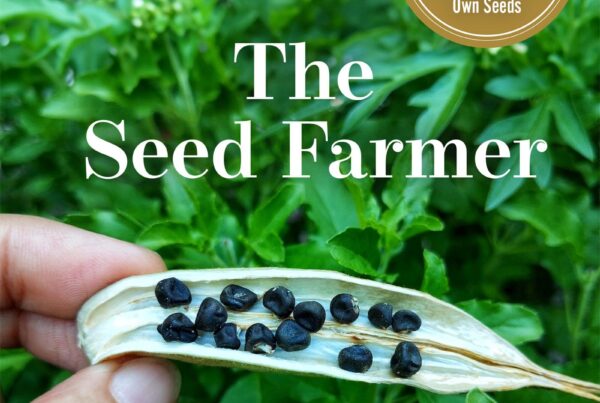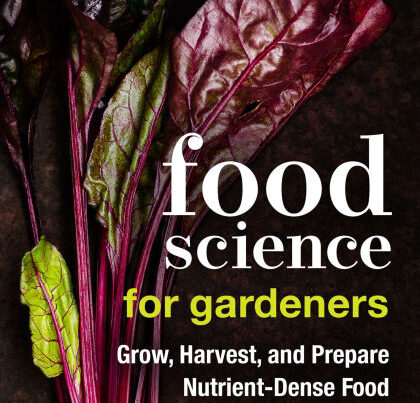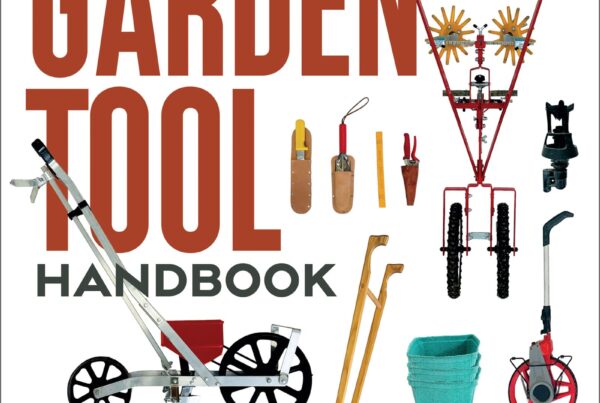The Winter Market Gardener: A Successful Grower’s Handbook for Year-Round Harvests, Jean-Martin Fortier and Catherine Sylvestre, New Society Publishers, October 2023. 256 pages, 7.5 x 9 inches, with color photos and drawings throughout. $39.99.
Jean-Martin Fortier’s first book, The Market Gardener, is a well-loved international best-seller. In this new book, he has worked with Catherine Sylvestre, to focus on cold-weather growing. Catherine is the director of vegetable production and leader of the market garden team at la Ferme des Quatres-Temps, in Hemmingford, Southern Quebec, Canada. The farm includes mixed livestock, an orchard and an 8-acre market garden designed and established by Jean-Martin Fortier. FQT was initiated by a local multi-millionaire who wanted to set up an experimental farm to demonstrate what was possible and to resolve some of the challenges in developing a diversified farm using efficient regenerative methods. The farm now has a second site, in Port-au-Persil, five hours away in the northern Charlevoix region.
At FQT, the authors train cohorts of employees and try out ideas that were not possible on the more limited budget of les Jardins de la Grelinette where Jean-Martin and his wife Maude-Hélène grew food for 200 families on two and a half acres. Since 2015, Maude-Hélène has been the solo operator of la Grelinette (an hour away from FQT).
With good techniques, equipment, and varieties, and enough personal energy, year-round production can provide premium local vegetables and make a profit. This book will inspire and help. It is packed with detailed vegetable profiles, tips for winter crop planning, and successful growing and storage of fall/winter crops. There is precise information on tool selection and best use, and on selecting shelters, from rowcover to high tunnels. The book was written in the authors’ native French and ably translated by Laurie Bennett. I love the word “shelters” to include all kinds of protected growing, and I hope it comes into common use in English!
The Winter Market Gardener builds on years of research, experimentation, and collaboration, as all who have read The Market Gardener will appreciate. It is a practical guide to winter vegetable production for small farmers in northern climates, and elsewhere. Initially I thought this would be a delight to read, but not of much practical use to me in central Virginia, a very different climate. I soon found I was wrong. Questions of the value and profitability of types of greenhouse and tunnel heating are thoroughly considered, in terms of heat sources, financial and planetary costs, and benefits. There is info on some crops I have never grown, not here nor in England. The crop planning calendars have solid info in a nice accessible intuitive format. There are charts, graphs, illustrations to help you get started or smooth your path in winter growing.
Don’t think for a minute that running a farm owned by a multi-millionaire means efficiency and results are unimportant! It does permit some enviable pricey equipment, but careful trials, record-keeping, and profitable products are essential to the purpose of the project.
The concept behind Ferme des Quatre-Temps is to find the sweet spot between intensive organic production, and a biodiverse landscape. Jean-Martin and a team of permaculturists came up with the design for the farm, including the livestock. The theories and practices are taught to a group of apprentices each year, and via the online Market Gardener Institute, and its Masterclass.
Whatever your level of experience or scale of production, The Winter Market Gardener will encourage and inspire you to value high-quality local vegetables all year, and give you tools to produce them in winter. There is an appendix for people wanting to use these methods on a backyard scale. 645 ft2 (60 m2) can grow enough vegetables for 3-5 people for the whole (Québécois!) winter. And, of course, you can grow summer vegetables there when winter is over.
Don’t think growing vegetables all-year means no time off – you just need to plan to include breaks, or rotate workdays around the crew. And remember that winter has shorter days and a slower pace than summer. For those growers pursuing an honest life of hard work on stuff that matters and makes a difference, here is a guidebook.
As the number of winter growers increases, the demand for fresh food increases, and we have job security! To be sustainable, winter harvesting must be profitable, so invest in this book. It may happen that small-scale winter food production becomes not just the tastiest option and least-damaging to the planet, but our only option. During the Covid pandemic, it became plain that in the Northeast of North America, 70% of vegetables come from California, Mexico, or even further afield. It took only three days to deplete the supply of fresh vegetables in the stores.
Some countries responded to this realization by providing grants for local food growing, including high tunnels and greenhouses. Catherine and Jean-Martin propose that giving the money to fifty or 200 small-scale farms would be a better investment than giving it to a twenty-hectare tomato greenhouse, (as happened in Quebec). Production of cold-hardy vegetables in winter uses much less energy than growing tomatoes! Additionally, growing summer vegetables in winter requires artificial lighting, causing light pollution, disrupting the circadian rhythms of humans and other animals. No one yet knows how artificial lighting affects the nutritional quality of food grown that way.
Jean-Martin and Catherine identify five key principles of winter growing:
- Lack of sunlight in winter is more limiting than lack of heat.
- Many vegetables can withstand freezing temperatures.
- Cold-hardiness in crops can sometimes be bred for.
- Layered shelters (rowcover, tunnels) can allow more vegetable production in winter.
- Installing minimal heating can make winter growing more successful, and can be profitable.
A useful chart suggests how many layers of rowcover to use at various night temperatures and daylengths. This guideline that could work wherever you grow.
There are good descriptions of making low tunnels and caterpillar tunnels. High tunnels (hoophouses, polytunnels, passive solar greenhouses) are permanently located and usable year-round, although unheated. Greenhouses are permanent structures, heated, somewhat insulated, made of glass or two layers of plastic. There is a small chart showing the outdoor killing temperatures of four crops, unprotected outdoors, in a high tunnel and in a high tunnel with P19 rowcover. For example, lettuce will die at 21°F (-6°C) outdoors with no protection, at 7°F (-14°C) outdoors if protected by a high tunnel, and at 0°F (-18°C) outdoors, if under rowcover in a high tunnel. This is followed by a comparison of the various shelters in terms of cost, thermal gain and features and uses.
Don’t consider adding heating unless you have at least a double layer of plastic and in-ground perimeter insulation. At la Ferme des Quatre-Temps they have perforated polyethylene tubing that distributes hot air along the beds. The increased revenue from faster growing crops must be covered by the increased costs of heating or adding more layers of rowcover. They present a table and a bar chart comparing cost of heating, cost of labor to manage row covers, and revenue. For their situation, heating to 37°F-41°F (3-5°C) trounces no heating, and beats heating to 54°F (12°C). It also matters how much workers are willing to move rowcovers, or enjoy doing that as part of winter growing.
To reduce heating costs, check your insulation. Regularly monitor and repair broken parts of your structure. If you are buying new, remember that bigger structures hold more warmth from the daytime. Ensure your heater is an efficient one, and you have blowers to push the heated air around.
Here’s a counterintuitive bit that makes complete sense once you’ve thought it through: On short cloudy days, there’s little point in adding heat, because the plants won’t be able to photosynthesize more. On warm sunny days, if the temperature is still low, your plants could gain photosynthesis with a higher temperature to balance the good light.
Avoid letting the humidity remain over 90% for more than a few days at a time. Ventilate, and if necessary, heat for an hour while doing that! Be sure to ventilate if the sun is shining. One of my hoophouse mantras this winter is “More air, less water!” – good airflow is vital to keep plants healthy.
As for heating, what fuel to use? Ecology is important, environmental awareness is a guiding value. Profitability has to be in there. Fossil fuels are not sustainable. Electricity produced by coal or nuclear power has no appeal. In Quebec, growers are fortunate to have hydroelectricity, from a publicly owned utility. Even with such a benign fuel source, there is still a decision to be made about the delivery system: a furnace with an electric coil or a heat pump? A short physics primer on electric heating follows. This gem of info can save you from a permanent expensive mistake! For example, surface geothermal might cost $10,000, but regular geothermal could cost $125,000! There’s a thorough table comparing pros and cons of various types of heating, and a full-page color photo of hot air distribution tubes.
The next section is on winter crop planning. To grow healthy winter crops, first grow strong seedlings with good roots, then harden them off carefully to withstand winter. Use a larger cell size than you would in simmer. Seven days before transplanting into the ground, move the seedlings into colder conditions with more outside air. Gradually increase their cold tolerance over the week.
Lack of light is more limiting than low temperatures. Careful timing is needed to get plants to the right size before daylength reduces to ten hours and growing slows right down. The key is to get plants to 70% of their final size before this happens. Further south, the dark period is shorter, the soil holds temperature until later in the year, and you have more wiggle room. In northern climates, greenhouses and tunnels become outdoor storage rooms.
There is a chart of winter days to maturity of tatsoi, spinach and turnips, and days to reach 70% full maturity. Days to maturity increase as daylength decreases. Keep records of winter days to maturity of the crops you grow, calculate 70% of that time and work back from your last day of ten hours of daylight, and find the target date to sow that crop. Keep records of sowing dates and results.
For a continuous supply of cut-and-come-again leaf crops, calculations are more complicated. Keep good notes of when you sow, cut, and can come-again. You might get three cuts, or six, depending on your location. Figure a good sowing date, and don’t delay! You could do some trials with short rows sown on different dates.
The authors provide a table of winter sowing dates for twenty-five crops sown outdoors with P19 rowcover; in a caterpillar tunnel; high tunnel; and minimally-heated greenhouse. Plants can sometimes endure an hour or two at a temperature considerably colder than they can tolerate for several days.
Crop density may need to be decreased to ensure plants get enough light and airflow. Growing plants closer in the row, but with rows further apart (growing about 70% the number of summer plants), provides better light. There’s an appendix on crop spacing.
It is helpful to know when each crop is likely to bolt after the solstice. Some bolt earlier than others. Keep records and harvest accordingly.
The crop profile section follows. There are icons indicating semi-hardy crops (32°F to 25°F/0°C to –4°C), cold-hardy ones (23°F to 14°F/–5°C to –10°C); very cold-hardy crops (14°F to 22°F/ −10°C to –30°C); minimal heating, no heating, overwintering; transplanted, and direct-sown crops. The sidebar also includes recommended varieties, spacing and seeding and transplant dates in Quebec. Each profile has a beautiful full-page watercolor image. The text includes info on first harvest, succession sowing, intercropping strategies, pest and disease challenges, and good harvest practices.
Next comes the section on recommended tools: broadfork, bed prep rake, (tilther perhaps), wheel hoe, two-wheel tractor (BCS), power harrow, rotary plow, (six-row seeder perhaps), Jang seeder, Earthway seeder, four-row pinpoint seeder (I could become a convert to this handy little tool!), stirrup hoe, collinear hoe, wire weeder, Terrateck wheel hoe with bio-discs, flex-tine weeder (looks good!), harvest knives, quick-cut greens harvester. 2023 prices are in an Appendix. I liked the home-made greens bubbler, a water tank with air bubbled into it, to agitate and clean the leaves.
Next is a section on tending your winter crops. How to have an unfrozen water supply (they don’t need any irrigation in unheated shelters in December or January). Why to avoid over-fertilizing (increased salt buildup, soil diseases, thrips and aphids). How to warm the soil, increase soil microbial activity, and rate of crop growth with landscape fabric, black plastic or rowcover. How to trap mice, and deal with pest insects when it is too cold for beneficial insects.
That section is followed by one about planning fall harvests of storage crops, which combines well with winter harvest of leafy greens, for more sales. Think not only of carrots, turnips and potatoes, but also of beets, cabbages, winter squash, parsnips, rutabagas, kohlrabi, onions, leeks, celeriac. There is. as always, encouragement to keep good records.
I really like their planting charts, where each crop is shown in its special color, occupying a physical amount of space (a column for each bed), and a time (rows for the weeks). With this plan in place, quick late summer crops can be squeezed into some beds, or cover crops. Each outgoing crop is flail-mowed, and covered with a silage tarp for two or three weeks. The soil micro-organisms break down the plant matter under the tarp, leaving the bed ready to replant without tilling. Tarping takes longer than tilling, but the method treats the soil and micro-organisms more holistically.
The general material about fall growing is followed by crop profile pages for suitable storage crops. Their method of transplanting beets gets better germination rates and uniformly filled beds. It gives me the idea of transplanting beets from thickly-emerged areas to gaps in our direct-sown beds, as we do with fall kale. There are helpful tips about carrots following garlic (we do this) because the soil will be relatively weed-free after months of garlic mulch; growing celeriac on landscape fabric, because it is in the bed for so long; storing Napa Chinese cabbage for 3 months in closed bins at high humidity; making sure not to create cracks in kohlrabi for storage; transplanting rutabagas. I’m a big fan of transplanting, but I’m learning about more crops that transplant well.
The authors advocate the same system we use for harvesting crops in the fall: determine the winter-kill temperature for each crop, list them in descending order, and work down the list, monitoring the weather forecast.
There is encouragement to build a well-insulated room with a household air-conditioner reconfigured using the CoolBot device to run at lower temperatures. If possible, make two storage rooms, one at 50°F-59°F (10°C-15°C) and one at 32°F-39°F (0°C-4°C). This is the first time I’ve seen advice to also install a heater, for occasions when outdoor temperatures are just too cold. I think we don’t need that in Virginia, but I believe Northerners do!
There are instructions about humidity, about managing ethylene and CO2, and managing inventory. There is a two-page table of storage conditions, containers, and length of storage for thirteen crops.
The last section of the book is Growing and Selling Vegetables Year-Round. Plan not to stand in the freezing cold all day at market! Options include a CSA; an online store with once-a-week deliveries to a select few locations; restaurant sales with a weekly Fresh List. Being reliable and communicating clearly is key, as is coordinating the orders and making a harvest list for the crew.
The world needs more small-scale year-round growers, supplying local markets. In Quebec in 2020, there were more start-up farms than farms closing down – the first time in fifty years! We do not need vertical farms of hydroponic vegetables, using large amounts of energy, priding themselves, curiously enough, on not using soil to produce food. Or food-like products. The diversity and flavor of four-season vegetables grown in soil can’t be beat.







